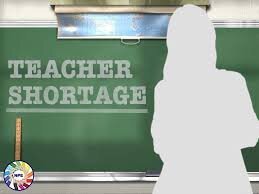EDU Trending: Why Is There A Huge Teacher Shortage?
Teacher shortage is not a new phenomenon in the United States, but since COVID, the number of teachers and staff leaving the profession has accelerated. The questions are: 1) Why is this happening? 2) Which areas and subjects are affected most? 3) What other factors are contributing to the crisis? 4) What can we do to address and reverse the trend?
In a 2021 Rand Corporation survey, almost 25% of teacher participants said they might leave their profession at the end of the school year, up from 17% before the pandemic (https://www. nea.org/advocating-for-change/new-from-nea/educators-ready-fall-teacher-shortage-looms)
Why is this happening? Teachers are chronically overworked, seriously underpaid, and disrespected.
Which areas and subjects are affected most? Special education, secondary Math, secondary Physical Sciences, Bi-Lingual Education along with shortages for substitute teachers and paraprofessionals (https://www.frontlineeducation.com/blog/teacher-shortage-2021/)
What other factors are contributing to the crisis? Social/emotional stress overall; Fear about the inadequacy of safety measures for themselves and the subsequent risk to their children; lack of professional training and administrator support; absence of instructional authority and autonomy; diminishing personal and professional job satisfaction and growth opportunities; dismissive disrespect.
What can we do to reverse the trend? Please read and ponder News and Views below. Then come up with some questions and solution of your own to add to the conversation.
Note: If you have expertise on the critical teacher shortage in the U.S., please share your views and recommendations in an article for my website. You will find submission requirements at: https://www.merleschell.com/in-your-own-words
News and Views: The Question Is How To Retain Teachers?
During the pandemic social/emotional stress soared - not only among students, parents, and school staff – but particularly among teachers resulting in the acute teacher shortage we are facing today https://www.cnbc.com/2021/04/19/1-in-4-workers-is-considering-quitting-their-job-after-the-pandemic.html What follows are some ideas for addressing and perhaps reversing that trend.
Social/emotional stress among teachers was itself the result of factors cited in EDU Trending that range from personal concerns over health and safety for themselves and their own families to professional issues that include low pay, lack of autonomy, insufficient professional development and technology support, plus overall disrespect and demoralization. It is a long list.
So, what can reasonably be done to make teachers want to stay in the classroom?
In no particular order, here are some ideas for your consideration: 1. Social well-being options: a) Weekly wellness check-ins and support groups in place of admin duties. b) Updating air filtration and adherence to other mitigating factors to insure teacher safety. c) Helping teachers find affordable and reputable child care for their own children. d) Flexible work options for health and safety. e) Allotment of “mental health days” in addition to sick days.
2. Professional options: a) Pay raises and signing bonuses. b) More planning time and fewer reports. c) College loan forgiveness for required Master’s degree. d) Instructional autonomy to meet state standards. e) Development of and training for alternative subject curricula and standards designed for remote learning. f) Re-imagined hierarchy with options for teachers who do not want to be administrators to move up in responsibility, authority, rank, and pay. g) Teacher job satisfaction a district priority.
Note: the above would be funded in part with COVID relief money allocated to school districts.
Teachers teach because they derive meaning, purpose, and joy in helping children to grow and achieve their best potential. It is a tough job - as parents found out during the year of remote learning. Why do we not respect teachers for their skill and dedication? Why do we not reward teachers financially and help them emotionally?
If we do not do what we should to keep our teachers, we will lose them. Then where will we and our children be?
Question of the Day:
How many new teachers leave their profession within the first 5 years?
11%
14%
26%
33%
42%
For the answer, please go to https://www.merleschell.com/reflections
From Me to You:
The three-part concept of Diversity, Equity, and Inclusion (DEI) is at the forefront of our national consciousness and conversation. DEI has become a core value and/or initiative in schools across the country. That is a good thing. It is important - for children and adults alike - to be able to listen and relate to one another.
But serious and weighty words often require a lot of explanation. To communicate effectively to heart as well as head, I propose that we honor the tenets of DEI by showing how they translate to relatable experiences of acceptance, belonging, and community (ABC). In this spirit, my early holiday gifts to you are the following texts (some come with unit and lesson plans) that you might like to explore with your students:
An Indian Father's Plea by Robert Blake
The-Jacket.pdf - iBlog Teacher Websites
Raymond's Run by Toni Cade Bambara
The Wrong Lunch Line By Nicholasa Mohr
The Leaving: Stories by Budge Wilson --The Metaphor, The
(Read the story “My Mother, My Father” in this collection.)
In these texts, people (real and fictional) will discover how to become more sensitive, insightful, and aware; why we should appreciate one another; and how we can speak and act in ways that are not judgmental, but rather are open-minded, kind, and relatable. Perhaps they will resonate and connect with your students as they have with mine.
Finally, please check out the reflection, Forging the Divide on my website at https://www.merleschell.com/reflections


